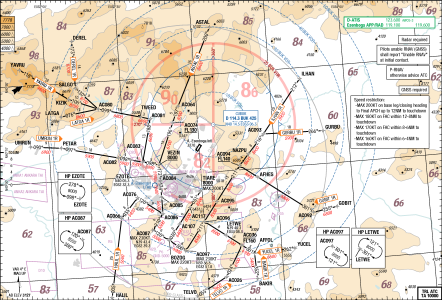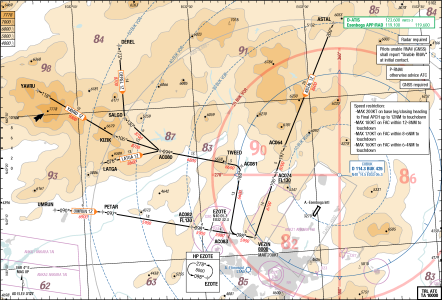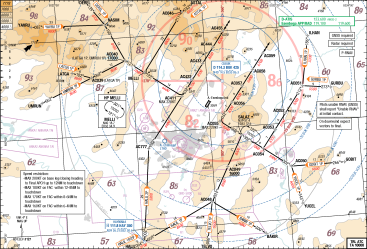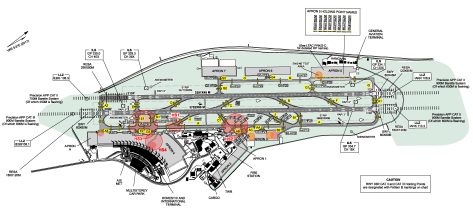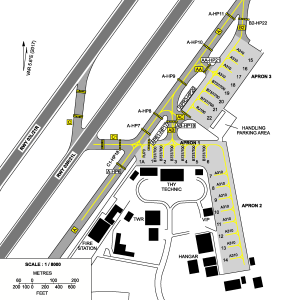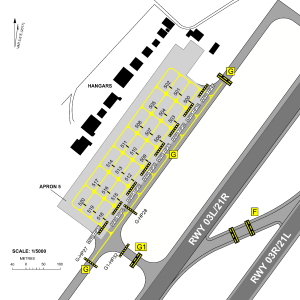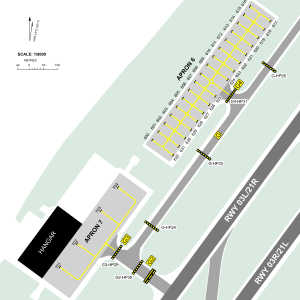Ankara Esenboğa Airport: Difference between revisions
(Added all ground parkings and aprons) |
(added several more sections) |
||
| Line 188: | Line 188: | ||
[[File:LT AD 2 LTAC PRKG D en APRON6-7.png|thumb|Apron 6 and 7]] | [[File:LT AD 2 LTAC PRKG D en APRON6-7.png|thumb|Apron 6 and 7]] | ||
Apron 7 is solely used by Turkish Government and its presidential planes. VATSIM is no place for politics, we do not restrict pilots from fly using government callsigns or simulate presidential flights however we do not allow politics. | Apron 7 is solely used by Turkish Government and its presidential planes. VATSIM is no place for politics, we do not restrict pilots from fly using government callsigns or simulate presidential flights however we do not allow politics. | ||
=== Planning Taxi Time === | |||
In Ankara Esenboğa Airport, taxi times are different for north and south config. When north config is in use, the taxi time for departure is about 5 minutes whereas for south config, it can be 10-15 minutes. Since arrival and departure traffic uses the same taxiway when south config is in use, there might be even delays to pushback and startup. | |||
=== Obtaining Clearance === | |||
When you ready to obtain your clearance, check the latest ATIS information. As there is no PDC service available in Ankara Esenboğa Airport, you need to call DEL controller for clearance. At first contact, report “Call Sign + Stand Position + ATIS Information”. | |||
=== Pushback and Engine Start === | |||
Just like any other airport, when you are ready for pushback and/or engine start, call GND controller using your callsign and stand number. The GND controller will either clear you or tell you standby due to external circumstances (traffic behind, area not clear, startup at X area restricted etc.). | |||
=== Taxi procedures === | |||
The taxi procedures are fairly simple. As there is one taxiway (TWY A) parallel to the runway and several taxiways connecting the apron to the taxiway A, the taxi routes are mostly easy to understand. When south config is active, departure traffic leaving apron 4 and joining A becomes an issue due to arrival traffic vacating at H. Traffics are expected to pay extra attention in situations like these. | |||
Intersection takeoffs are mandatory unless advised by ATC. '''Expect E1 and E for taxi for 03L departures'''. | |||
== Departure Procedures == | |||
=== RECAT - LTAC === | |||
With the introduction of "Wake Turbulence Re-categorisation" in Turkish Airspace, the conventional wake turbulence categories has been re-defined. You can find more information from [https://www.skybrary.aero/articles/recat-wake-turbulence-re-categorisation Skybrary using this link]. | |||
{| class="wikitable" | |||
!RECAT LTBS | |||
!Follower | |||
!Super Heavy | |||
!Upper Heavy | |||
!Lower Heavy | |||
!Upper Medium | |||
!Lower Medium | |||
!Light | |||
|- | |||
!Leader | |||
| | |||
!A | |||
!B | |||
!C | |||
!D | |||
!E | |||
!F | |||
|- | |||
!Super Heavy | |||
!A | |||
|80s | |||
|100s | |||
|120s | |||
|140s | |||
|160s | |||
|180s | |||
|- | |||
!Upper Heavy | |||
!B | |||
|80s | |||
|80s | |||
|80s | |||
|100s | |||
|120s | |||
|140s | |||
|- | |||
!Lower Heavy | |||
!C | |||
|80s | |||
|80s | |||
|80s | |||
|80s | |||
|100s | |||
|120s | |||
|- | |||
!Upper Medium | |||
!D | |||
|80s | |||
|80s | |||
|80s | |||
|80s | |||
|80s | |||
|120s | |||
|- | |||
!Lower Medium | |||
!E | |||
|80s | |||
|80s | |||
|80s | |||
|80s | |||
|80s | |||
|100s | |||
|- | |||
!Light | |||
!F | |||
|80s | |||
|80s | |||
|80s | |||
|80s | |||
|80s | |||
|80s | |||
|} | |||
===Minimum Runway Occupancy Time for Departures=== | |||
Minimum runway occupancy time is applied to all landing and departing aircraft. This is to minimize the occupancy time of the only runway that is available for both departures and arrivals: | |||
*To optimize the runway utilization, flight crews shall complete all check lists prior to line-up clearance and be ready for immediate take-off, | |||
*When aircraft is at the RWY holding point, pilots should commence line-up and take off roll immediately after take-off clearance is issued by ATC, | |||
*When aircraft is already lined-up on RWY, pilots should commence take off roll immediately after take-off clearance is issued by ATC, | |||
*Pilots are expected to react take-off clearances within 10 seconds, | |||
*Pilots unable to comply with these requirements shall notify ATC before entering the RWY, otherwise ATC may instruct the aircraft to vacate the RWY and re-sequence to prevent excessive RWY occupation. | |||
Revision as of 23:37, 9 October 2023
Ankara Esenboğa Airport (IATA: ESB, ICAO: LTAC) is the international airport of Ankara, which is the capital of Türkiye. Located in north of the capital, the airport is one of the oldest airports in the country. The airport currently ranks as the 4th busiest airport in the country behind Istanbul Airport, Antalya Airport and Sabiha Gökçen Airport).
The airport has 2 parallel runways, right next to each other (03L/R - 21L/R). East of the runways, the main passenger terminal, MRO facilities and control tower is located. On the west side, there are 3 aprons which house general aviation facilities, government hangars, flight schools. It also houses Ankara ACC (Türkiye Hava Trafik Kontrol Merkezi) which covers the entire Türkiye, about 900nm from one end to other.
Sceneries
Payware
There are multiple payware options depending on the simulator for Istanbul Airport. You can find more information from the table below.
| Simulator | Developer | Publisher | Links |
|---|---|---|---|
| FSX, P3D v2/v3/v4/v5 | SceneryTR | SimMarket | https://secure.simmarket.com/scenerytr-ltac-ankara-esenboa-airport-fsxp3dv4.phtml |
| Microsoft Flight Simulator 2020 | SceneryTR | SimMarket | Can be bought from MarketPlace or
https://secure.simmarket.com/scenerytr-ltac-ankara-esenboa-airport_msfs.phtml |
Freeware
There are also freeware options available for Istanbul Airport. However there is significant difference in quality.
| Simulator | Developer | Publisher | Links |
|---|---|---|---|
| FSX | Ahmet Özler | Sanalpilot | http://www.sanalpilot.com/forum/showthread.php?16383-LTAC2013-Ahmet-%D6zler-den-FSX-i%E7in-Ankara-Esenbo%F0a-Havaliman%FD |
| X-Plane 11/12 | Argaeus | Threshold Forum | https://forum.thresholdx.net/files/file/530-ltac-ankara-esenboga/ |
| Microsoft Flight Simulator 2020 | Argaeus | Flightsim.to | https://flightsim.to/file/10880/ltac-ankara-esenboga-intl-airport |
Preferential Runway System (PRS)
The term “Preferential RWY System (PRS)” shall be used to indicate the runway that, at a particular time, is considered by the ATC unit to be the most suitable for use by the aircraft expected to land at or take-off from the aerodrome, by taking into consideration aircraft performance, surface wind speed and its components. PRS Operations contribute to the optimum use of airspace and aerodrome capacity.
The Preferential Runways in Ankara Esenboğa Airport (LTAC) are north configuration runways (03L/R) East runway is used for landing, west runway for takeoff
| RWYCC (Runway Condition Code) | Tail Wind Component (max) |
|---|---|
| RWYCC 6/6/6
(dry, maximum braking) |
10 KT (included) |
| When RWYCC is reported at least 5 for any each runway third
(worse than dry, low braking |
5 KT (included) |
- In the PRS operations, the above wind criteria depending on the runway surface condition shall be applied.
- During the PRS operations, ATC unit takes into account the ground wind, traffic situation, local meteorological conditions, environmental restrictions, technical infrastructure, noise abatement, etc.
- PRS operations will not be available under the following circumstances:
- The instrument approach/departure procedures available for the preferred RWY(s) are not convenient for landing and/ or take-off operations under the existing meteorological conditions
- When the preferred RWY(s) are dry (RWYCC[1] 6/6/6), the tail wind component is greater than 10 Kt,
- When RWYCC is reported at least 5 for any each the preferred RWY(s) third, the tail wind component is greater than 5 Kt,
- When RWYCC is reported at least 5 for any each the preferred RWY(s) third, there is a NOTAM/equivalent information (which may be included in the RCR) stating that the runway is slippery, ATIS announcement when PRS Operations are in progress shall be; “Preferential Runway Operations are in Progress”.
- RWYCC is reported 4 or less any each the preferred RWY(s) third,
- Meteorological conditions such as heavy rainfall, thunderstorm or wind-shear has been reported on the approach or climb path of the preferred RWY(s),
- Low visibility operations are in progress.
- ATIS announcement when PRS Operations are in progress shall be; “Preferential Runway Operations are in Progress”.
- Pilots unable to comply with PRS Operations shall notify the relevant ATC unit at the time of requesting start-up clearance, at the first contact or 20 minutes in advance of the ETA (which is earlier).
Arrival Procedures
Introduction
Ankara Esenboğa Airport is located within Ankara TMA (Terminal Manoeuvring Area). Ankara TMA covers Ankara Esenboğa Airport (LTAC), Güvercinlik Airport (LTAB, military), Etimesgut Airport (LTAD, military and Ankara Murted Airbase (LTAE, military). Due to high military activity and restricted areas within the TMA, there might be lot of vectoring or holds upon arrival.
Ankara Esenboğa Airport utilizes RNAV in all of its STAR procedures. In addition, P-RNAV (Precision-Area Navigation, RNP1) capability is required. If unable, pilot must inform the controller so that aircraft can be given radar vectors to final.
Important things to keep in mind:
- Vacating aircraft has priority at the intersection of the parallel taxiway.
- After the runway is vacated, do not report vacated to TWR* and DO NOT STOP on rapid-exit taxiways.
*unless LVP is in progress. Check next section for more details.
Low Visibility Procedure
When LVP are in progress, every traffic must report "Vacated" to the TWR, as verbal confirmation from the traffic is mandatory and for the TWR to know the runway is available for the next traffic.
STARs
The STARs at Ankara Esenboğa Airport are different for each config. approach whereas for South config (RWY 21L/R), the STARs end at downwind where the APP controller will vector the traffic to final.
| Active Runway Configuration | ||||||
|---|---|---|---|---|---|---|
North Configuration uses the following STAR identifiers.
| ||||||
South Configuration uses the following STAR identifiers.
|
North Configuration (RWY 03L/R)
The STAR structure for north configuration is focused on tight turns with long having the aircraft navigate around restricted areas. Both 1R and 1Z STAR's last waypoint is the IAF for ILS-V 03R. For instance, 1Z STARs last waypoint is TIARE, which is the start of one of the transitions for the approach procedure. For 1R arrivals, VEZIN is the last waypoint which joins the transition of the approach from the east.
South Configuration (RWY 21L/R)
The arrivals for south config is very simple. There is no approach transition and there is no base or final. Final waypoint is VECTORS which means after downwind, especially after AC455, traffics are expected to maintain present heading and should expect vectors to final from the APP controller.
The difference between 1P and 2P is only applicable to the HALIL STAR. HALIL 1P will navigate the traffic to join east downwind whereas 2P will join the west downwind.
Ground Operations
Ground Layout
Ankara Esenboğa Airport consists of 2 parallel runways, 8 aprons scattered around airport. Note, the right layout is oriented as WEST up.
Apron, Gates and Stands
Apron 1, Apron 2 and Apron 3
Apron 1 and 2 is a single taxiway apron which extends from TWY A until the cargo buildings which are located at the end of apron 2. The stands go from 1A, 1, ..., 14. VIP, THY Technic, ATC Tower, Customs and few other facilities are located in this area.
Apron 3 also has a dedicated de-icing area located on stands 15-16.
Apron 4 and A
Apron 4 and A are side by side aprons however Apron A is only used for government or head of state flights.
Apron 4 has 9 stands and 18 gates (2 heavy, 16 medium). The main passenger terminal is also located in this apron. Both international and domestic flights are conducted from the same terminal.
The terminal is a modular terminal, the gates 113-115 can be designated either international nor domestic, meaning according to the number of international and domestic flights, the domestic or international section can be grown by closing/opening sliding doors between the gates. For example if there are more domestic flights around 14-15 UTC, the domestic section can be extended all the way to gates 115 by closing the sliding doors between gates 115 and 116, then opening all the sliding doors between 116-113.
| Gates | Aircraft Type | Domestic | International |
|---|---|---|---|
| 103 | Widebody | X | |
| 104-112 | Narrowbody | X | |
| 113-115 | Narrowbody | X | X |
| 116-119 | Narrowbody | X | |
| 120 | Widebody | X |
Apron 5
Apron 5 is filled with smaller hangers and is mostly used for general aviation. Most of the hangers are occupied by flight schools both for MRO and lecturing purposes.
Apron 6 and 7
Apron 6 is kind of an extension to apron 5, mostly used for general aviation, leisure and executive aviation. Business jets or other smaller VIP aircraft can be seen at this apron as well.
Apron 7 is solely used by Turkish Government and its presidential planes. VATSIM is no place for politics, we do not restrict pilots from fly using government callsigns or simulate presidential flights however we do not allow politics.
Planning Taxi Time
In Ankara Esenboğa Airport, taxi times are different for north and south config. When north config is in use, the taxi time for departure is about 5 minutes whereas for south config, it can be 10-15 minutes. Since arrival and departure traffic uses the same taxiway when south config is in use, there might be even delays to pushback and startup.
Obtaining Clearance
When you ready to obtain your clearance, check the latest ATIS information. As there is no PDC service available in Ankara Esenboğa Airport, you need to call DEL controller for clearance. At first contact, report “Call Sign + Stand Position + ATIS Information”.
Pushback and Engine Start
Just like any other airport, when you are ready for pushback and/or engine start, call GND controller using your callsign and stand number. The GND controller will either clear you or tell you standby due to external circumstances (traffic behind, area not clear, startup at X area restricted etc.).
Taxi procedures
The taxi procedures are fairly simple. As there is one taxiway (TWY A) parallel to the runway and several taxiways connecting the apron to the taxiway A, the taxi routes are mostly easy to understand. When south config is active, departure traffic leaving apron 4 and joining A becomes an issue due to arrival traffic vacating at H. Traffics are expected to pay extra attention in situations like these.
Intersection takeoffs are mandatory unless advised by ATC. Expect E1 and E for taxi for 03L departures.
Departure Procedures
RECAT - LTAC
With the introduction of "Wake Turbulence Re-categorisation" in Turkish Airspace, the conventional wake turbulence categories has been re-defined. You can find more information from Skybrary using this link.
| RECAT LTBS | Follower | Super Heavy | Upper Heavy | Lower Heavy | Upper Medium | Lower Medium | Light |
|---|---|---|---|---|---|---|---|
| Leader | A | B | C | D | E | F | |
| Super Heavy | A | 80s | 100s | 120s | 140s | 160s | 180s |
| Upper Heavy | B | 80s | 80s | 80s | 100s | 120s | 140s |
| Lower Heavy | C | 80s | 80s | 80s | 80s | 100s | 120s |
| Upper Medium | D | 80s | 80s | 80s | 80s | 80s | 120s |
| Lower Medium | E | 80s | 80s | 80s | 80s | 80s | 100s |
| Light | F | 80s | 80s | 80s | 80s | 80s | 80s |
Minimum Runway Occupancy Time for Departures
Minimum runway occupancy time is applied to all landing and departing aircraft. This is to minimize the occupancy time of the only runway that is available for both departures and arrivals:
- To optimize the runway utilization, flight crews shall complete all check lists prior to line-up clearance and be ready for immediate take-off,
- When aircraft is at the RWY holding point, pilots should commence line-up and take off roll immediately after take-off clearance is issued by ATC,
- When aircraft is already lined-up on RWY, pilots should commence take off roll immediately after take-off clearance is issued by ATC,
- Pilots are expected to react take-off clearances within 10 seconds,
- Pilots unable to comply with these requirements shall notify ATC before entering the RWY, otherwise ATC may instruct the aircraft to vacate the RWY and re-sequence to prevent excessive RWY occupation.
- ↑ Runway Condition Code
